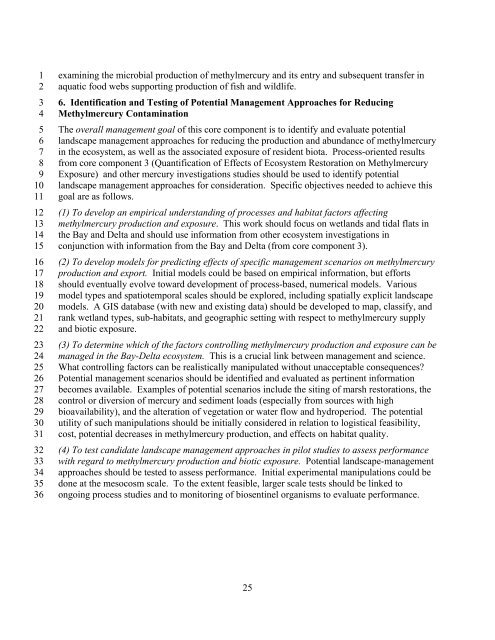Mercury Strategy for the Bay-Delta Ecosystem - CALFED Bay-Delta ...
Mercury Strategy for the Bay-Delta Ecosystem - CALFED Bay-Delta ...
Mercury Strategy for the Bay-Delta Ecosystem - CALFED Bay-Delta ...
Create successful ePaper yourself
Turn your PDF publications into a flip-book with our unique Google optimized e-Paper software.
1<br />
2<br />
3<br />
4<br />
5<br />
6<br />
7<br />
8<br />
9<br />
10<br />
11<br />
12<br />
13<br />
14<br />
15<br />
16<br />
17<br />
18<br />
19<br />
20<br />
21<br />
22<br />
23<br />
24<br />
25<br />
26<br />
27<br />
28<br />
29<br />
30<br />
31<br />
32<br />
33<br />
34<br />
35<br />
36<br />
examining <strong>the</strong> microbial production of methylmercury and its entry and subsequent transfer in<br />
aquatic food webs supporting production of fish and wildlife.<br />
6. Identification and Testing of Potential Management Approaches <strong>for</strong> Reducing<br />
Methylmercury Contamination<br />
The overall management goal of this core component is to identify and evaluate potential<br />
landscape management approaches <strong>for</strong> reducing <strong>the</strong> production and abundance of methylmercury<br />
in <strong>the</strong> ecosystem, as well as <strong>the</strong> associated exposure of resident biota. Process-oriented results<br />
from core component 3 (Quantification of Effects of <strong>Ecosystem</strong> Restoration on Methylmercury<br />
Exposure) and o<strong>the</strong>r mercury investigations studies should be used to identify potential<br />
landscape management approaches <strong>for</strong> consideration. Specific objectives needed to achieve this<br />
goal are as follows.<br />
(1) To develop an empirical understanding of processes and habitat factors affecting<br />
methylmercury production and exposure. This work should focus on wetlands and tidal flats in<br />
<strong>the</strong> <strong>Bay</strong> and <strong>Delta</strong> and should use in<strong>for</strong>mation from o<strong>the</strong>r ecosystem investigations in<br />
conjunction with in<strong>for</strong>mation from <strong>the</strong> <strong>Bay</strong> and <strong>Delta</strong> (from core component 3).<br />
(2) To develop models <strong>for</strong> predicting effects of specific management scenarios on methylmercury<br />
production and export. Initial models could be based on empirical in<strong>for</strong>mation, but ef<strong>for</strong>ts<br />
should eventually evolve toward development of process-based, numerical models. Various<br />
model types and spatiotemporal scales should be explored, including spatially explicit landscape<br />
models. A GIS database (with new and existing data) should be developed to map, classify, and<br />
rank wetland types, sub-habitats, and geographic setting with respect to methylmercury supply<br />
and biotic exposure.<br />
(3) To determine which of <strong>the</strong> factors controlling methylmercury production and exposure can be<br />
managed in <strong>the</strong> <strong>Bay</strong>-<strong>Delta</strong> ecosystem. This is a crucial link between management and science.<br />
What controlling factors can be realistically manipulated without unacceptable consequences?<br />
Potential management scenarios should be identified and evaluated as pertinent in<strong>for</strong>mation<br />
becomes available. Examples of potential scenarios include <strong>the</strong> siting of marsh restorations, <strong>the</strong><br />
control or diversion of mercury and sediment loads (especially from sources with high<br />
bioavailability), and <strong>the</strong> alteration of vegetation or water flow and hydroperiod. The potential<br />
utility of such manipulations should be initially considered in relation to logistical feasibility,<br />
cost, potential decreases in methylmercury production, and effects on habitat quality.<br />
(4) To test candidate landscape management approaches in pilot studies to assess per<strong>for</strong>mance<br />
with regard to methylmercury production and biotic exposure. Potential landscape-management<br />
approaches should be tested to assess per<strong>for</strong>mance. Initial experimental manipulations could be<br />
done at <strong>the</strong> mesocosm scale. To <strong>the</strong> extent feasible, larger scale tests should be linked to<br />
ongoing process studies and to monitoring of biosentinel organisms to evaluate per<strong>for</strong>mance.<br />
25

















